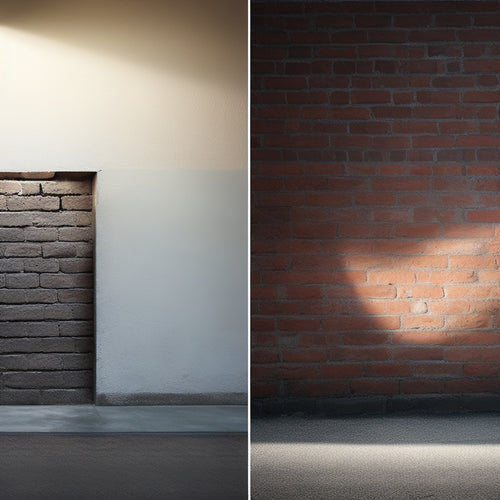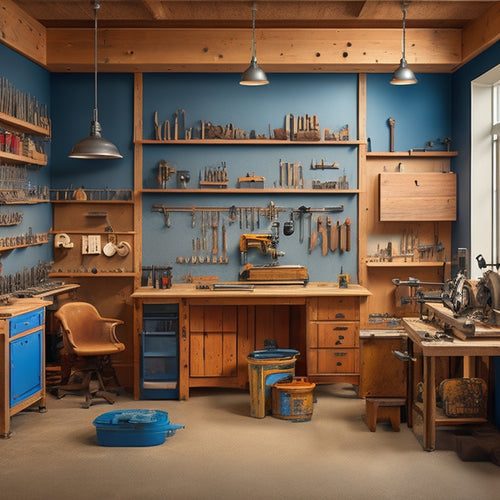
3 Best Tools for Plaster Wall Finishing Renovation
Share
When renovating plaster walls, you'll need the right tools to achieve a smooth finish. Start with a power sander to handle coarse to fine sanding techniques, followed by a HEPA filter vacuum to remove dust and debris. A putty knife is also essential for applying joint compound and smoothing out surfaces. These three tools will help you achieve a solid foundation for your renovation. By combining them with the right techniques and additional tools, you'll be well on your way to a professional-looking finish – and there's more to explore to guarantee your plaster wall renovation turns out flawless.
Key Takeaways
- A power sander is essential for achieving a smooth finish on plaster walls, handling various sanding techniques from coarse to fine.
- A HEPA filter vacuum is vital for removing dust and debris, preventing dust spread and ensuring a clean workspace during renovation.
- A putty knife is necessary for applying joint compound, aiding in smoothing out surfaces and filling gaps in plaster walls.
- A good quality trowel is crucial for applying and smoothing plaster, with options including putty knives and finishing trowels for detail work.
- An orbital sander is best for fine-tuning and polishing plaster walls, providing a smooth finish and professional-looking result.
Essential Kit for Finishing
When it comes to plaster wall finishing, you'll need a few must-have tools in your arsenal to get the job done efficiently and effectively.
A power sander is an essential tool for achieving a smooth finish. You'll want to invest in a high-quality sander that can handle various sanding techniques, from coarse to fine. This will allow you to tackle surface preparation with ease, removing imperfections and creating a uniform base for finishing.
In addition to a power sander, a vacuum cleaner with a HEPA filter is vital for removing dust and debris from the sanding process. This will prevent dust from spreading to other areas of the room and guarantee a clean working environment.
A putty knife and a joint knife are also must-haves for applying and smoothing out joint compound. A level and a straightedge will help you achieve a precise finish, while a pencil and a marker will aid in marking areas that require additional attention.
Hand Tools for Plastering Tasks
You've got your power tools covered, but now it's time to focus on the hand tools that'll help you refine your plastering skills.
Hand tools are essential for precise plastering techniques, allowing you to work with accuracy and finesse. When choosing hand tools, consider durability and ease of maintenance, as proper tool maintenance is vital for extending their lifespan.
Here are the essential hand tools for plastering tasks:
-
Hawks: A hawk is a flat, rectangular tool used to hold and carry plaster. It's typically made of metal or plastic and has a comfortable grip handle.
-
Trowels: A trowel is a handheld tool used to apply and smooth plaster. There are different types of trowels, including putty knives and finishing trowels.
-
Joint knives: A joint knife is a small, handheld tool used to fill and smooth joints and seams.
- Sponges: A sponge is used to apply texture and smooth out plaster. Natural sea sponges are ideal for creating unique textures and patterns.
Power Tools for Smooth Finishes
Power tools are the backbone of a smooth plaster wall finish, providing the necessary muscle to efficiently complete large-scale tasks and achieve high-quality results.
When it comes to power tools, you'll want to focus on those that help you achieve a smooth finish. A good sander is essential for this process. When selecting a sander, consider the type of plaster you're working with and the level of smoothness you need to achieve. For example, a belt sander is ideal for removing old plaster and smoothing out rough surfaces, while an orbital sander is better suited for fine-tuning and polishing.
Polishing techniques are also vital for achieving a smooth finish. Use a series of progressively finer grits to polish the plaster, starting with a coarse grit and working your way up to a fine grit. This will help remove any imperfections and leave a smooth, even surface.
Additionally, consider using a power tool with a polishing attachment, such as a rotary polisher, to help achieve a high-gloss finish. By combining the right power tools with effective polishing techniques, you'll be able to achieve a smooth, professional-looking finish on your plaster walls.
Frequently Asked Questions
What Are Common Plastering Mistakes Beginners Make on Their First Renovation Project?
When tackling your first renovation project, you'll likely encounter common plastering mistakes, such as applying uneven plaster thickness and using incorrect finishing techniques, which can lead to a subpar finish and costly rework.
Can You Paint Directly on Plaster or Is Special Prep Work Needed First?
When painting directly on plaster, you'll need to prep the surface first. Use plaster painting techniques that involve cleaning, patching holes, and applying a primer to create a smooth, even finish, ensuring ideal surface preparation.
Is There a Standard Width for Skim Coats Applied Over Joints and Fasteners?
As you commence on this renovation quest, consider this: skim coat techniques require precision. For joint finishing, a standard width of 2-3 inches (5-7.5 cm) is common, allowing for seamless integration of joints and fasteners.
Do Soundproofing Products Have Special Application Procedures on Plaster?
When applying soundproofing products on plaster, you'll need to follow specific procedures to guarantee ideal acoustic insulation. Typically, you'll apply a specialized adhesive, then press the soundproofing material firmly onto the plaster, ensuring a seamless bond.
Is Renovating Old Lath-And-Plaster Ceilings Usually Diy-Possible for Most Homeowners?
When renovating old lath-and-plaster ceilings, you'll find it DIY-possible, but you'll need specific tools. A joint compound knife, sanding blocks, and a plaster mix will help with ceiling repair. Measure and prepare carefully.
Conclusion
As you step back to admire your handiwork, the newly finished plaster walls gleam like polished stone. Your renovation project is transformed, with every bump and imperfection erased. With the right tools, you've achieved a silky smooth finish that's as durable as it is beautiful. The plaster's subtle sheen seems to glow, inviting you to run your hand over its cool surface. Your hard work has paid off – the results are truly professional.
Related Posts
-

Why Use Concrete Blocks in Home Renovation
You're considering using concrete blocks in your home renovation, and for good reason: they offer a unique combinatio...
-

Crack Repair Inspection Checklist for Home Renovation
When creating a crack repair inspection checklist for your home renovation project, you'll want to identify crack typ...
-

Renovation Tool Checklist for Smooth Finishes
When tackling a renovation project that requires a smooth finish, you'll need a thorough tool checklist to guarantee ...


